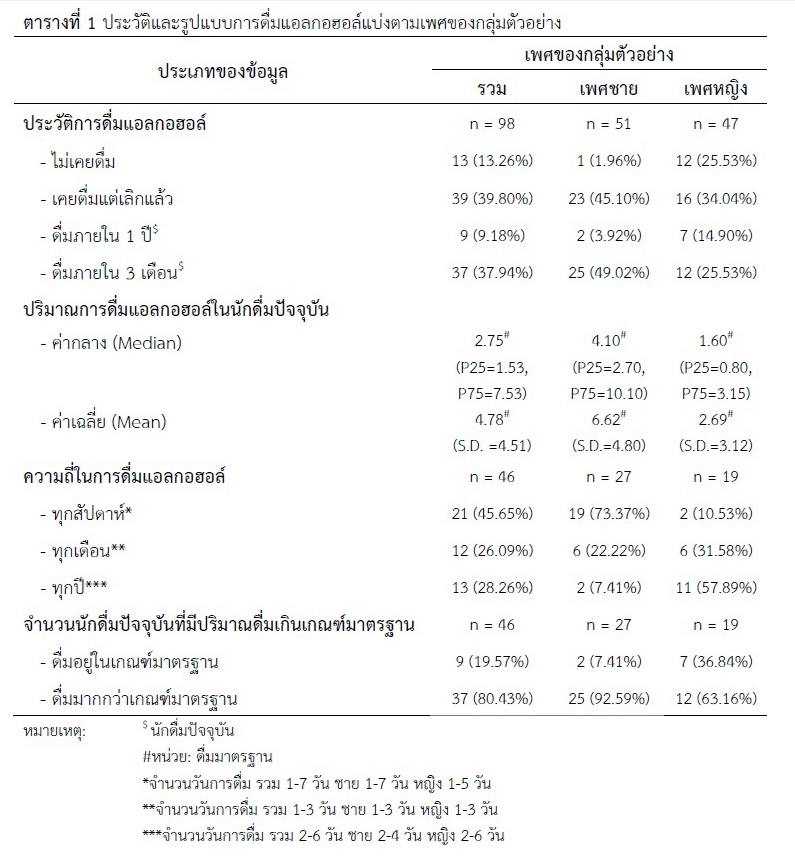พฤติกรรมการดื่มแอลกอฮอล์ในผู้ป่วยโรคความดันโลหิตสูง โรงพยาบาลเชียงแสน
คำสำคัญ:
พฤติกรรมการดื่มแอลกอฮอล์, ผู้ป่วยโรคความดันโลหิตสูงบทคัดย่อ
การศึกษาวิจัยเชิงพรรณนานี้มีวัตถุประสงค์เพื่อศึกษาพฤติกรรมการดื่มแอลกอฮอล์เชิงลึกของผู้ป่วยโรคความดันโลหิตสูงที่มารับบริการที่คลินิกโรคเรื้อรังโรงพยาบาลเชียงแสน จังหวัดเชียงราย จำนวน 98 คน คัดเลือกตัวอย่างแบบบังเอิญ เก็บข้อมูลโดยการสัมภาษณ์จากแบบสอบถามข้อมูลทั่วไป การเจ็บป่วยด้วยโรคความดันโลหิตสูง ประวัติและรูปแบบการดื่ม ปัญหาการดื่มแอลกอฮอล์ และการรับรู้ผลกระทบของแอลกอฮอล์ต่อความดันโลหิตสูง สถิติที่ใช้วิเคราะห์ข้อมูลได้แก่ Mann-Whitney U test
ผลการศึกษาพบว่ากลุ่มตัวอย่างเป็นเพศชายร้อยละ52.04 เพศหญิงร้อยละ 47.96 ส่วนใหญ่ถือสัญชาติไทยร้อยละ 92.86 อายุเฉลี่ย 59.71 ปี พฤติกรรมการดื่มแอลกอฮอล์ใน1ปีที่ผ่านมาพบมีกลุ่มตัวอย่างที่เป็นนักดื่มปัจจุบันร้อยละ 46.94 มีปริมาณการดื่มเฉลี่ยต่อครั้งเท่ากับ 4.78 ดื่มมาตรฐานและพบความแตกต่างอย่างมีนัยยะสำคัญทางสถิติของค่ากลางปริมาณการดื่มแอลกอฮอล์ในเพศชายและเพศหญิงที่ 4.10 ดื่มมาตรฐานและ 1.60 ดื่มมาตรฐานตามลำดับ ความถี่ในการดื่มส่วนใหญ่อยู่ในช่วง1-7วันต่อสัปดาห์ ร้อยละ 45.65 พฤติกรรมการดื่มจัดอยู่ในกลุ่มความเสี่ยงน้อยร้อยละ 58.70 ระดับการเปลี่ยนแปลงพฤติกรรมอยู่ในขั้นตัดสินใจมากที่สุดร้อยละ 36.96 และเป็นที่น่าสังเกตว่ามีกลุ่มตัวอย่างร้อยละ 7.14 ที่ยังไม่ทราบหรือเข้าใจผิดเกี่ยวกับผลกระทบของแอลกอฮอล์ต่อโรคความดันโลหิตสูงโดยทั้งหมดเป็นกลุ่มนักดื่มปัจจุบัน
ข้อเสนอแนะบุคลากรสุขภาพควรให้ความสำคัญกับการจำกัดจำนวนการดื่มแอลกอฮอล์ซึ่งถือเป็นหนึ่งในวิธีการรักษาด้วยการปรับเปลี่ยนพฤติกรรมให้มากขึ้น และเนื่องจากยังมีผู้ป่วยที่เป็นกลุ่มนักดื่มปัจจุบันส่วนหนึ่งยังไม่ทราบถึงผลกระทบดังกล่าว จึงควรจัดให้มีการให้ความรู้เกี่ยวกับผลกระทบแอลกอฮอล์ในผู้ป่วยโรคความดันโลหิตสูงทุกราย
เอกสารอ้างอิง
-data.php. (2017, 28 March). (in Thai).
Bureau of Non Communicable Diseases. (2016). Campaign issue world hypertension day 2016. [online], Available: https://www.thaincd.com/document/file/info/
noncommunicabledisease/ Issue of the campaign for high blood pressure day 2016.pdf. (2017, 28. March). (in Thai).
Center for alcohol studies. (2013). The situation of alcohol consumption and effects in Thailand 2013. Nonthaburi: The graphico system. (in Thai).
Center for alcohol studies. (2013). Provincial Alcohol Report 2011. Nonthaburi: The graphic system. (in Thai).
Center for alcohol studies. (2016). The situation of alcohol consumption in northern
Thailand 2015. Bangkok: Duentula publisher. (in Thai).
Darunee phukao, et al. (2010). The Contemplation Ladder. Motivational Interviewing and Motivational Enhancment Therapy: MI&MET. Chiangmai: Integrated Management for Alcohol Intervention Program. 5-19-5-21. (in Thai).
James PA, et al. (2014). Evidence-based guideline for the management of high blood pressure in adults: report from the panel members appointed to the Eighth Joint National Committee (JNC 8).
Kazim Husain, et al. (2014). Alcohol-induced hypertension: Mechanism and prevention. World Journal of Cardiology.
6(5), 245-252.
Mananchaya Sereewiwattana. (2016). Association of alcohol consumption behaviors and clinical outcome among hypertension patient. Journal of public health nursing. 3(2), 81-97. (in Thai).
NCD Clinic, Chiang-sean hospital. Patient data by Hosxp V.4.0. Chiangrai. (in Thai).
Phunnapa Kittirattanapaiboon (2010). Manual for practitioners: An approach to treatment of alcoholic patient in health system 2010. Chiangmai: Integrated Management for Alcohol Intervention Program. 14-17. (in Thai).
Phunnapa Kittirattanapaiboon, Paritat Silpakit. (2009). AUDIT (Thai version). Chiangmai: Tantawanpaper. (in Thai).
Thai Hypertension Society. (2015). Thai Guidelines on the Treatment of Hypertension 2012 update 2015. 6-30. (in Thai).
World Health Organization. (2015). Global Health Observatory (GHO) data, Raised blood pressure. [online], Available: https://www.who.int/gho/ncd/risk_factors/
blood_pressure_prevalence_text/en. (2017, 28, March)

ดาวน์โหลด
เผยแพร่แล้ว
ฉบับ
ประเภทบทความ
สัญญาอนุญาต
บทความ ข้อมูล เนื้อหา รูปภาพ ฯลฯ ที่ได้รับการตีพิมพ์ในวารสารวารสารวิชาการสุขภาพภาคเหนือ ถือเป็นลิขสิทธิ์ของวารสารวารสารวิชาการสุขภาพภาคเหนือ หากบุคคลหรือหน่วยงานใดต้องการนำทั้งหมดหรือส่วนหนึ่งส่วนใดไปเผยแพร่ต่อหรือเพื่อกระทำการใดๆ จะต้องได้รับอนุญาตเป็นลายลักอักษรจากวารสารวารสารวิชาการสุขภาพภาคเหนือก่อนเท่านั้น
เนื้อหาและข้อมูลในบทความที่ลงตีพิมพ์ในวารสารวิชาการสุขภาพภาคเหนือถือเป็นข้อคิดเห็นและความรับผิดชอบของผู้เขียนบทความโดยตรงซึ่งกองบรรณาธิการวารสาร ไม่จำเป็นต้องเห็นด้วย หรือร่วมรับผิดชอบใดๆ
อนึ่ง ข้อความและข้อคิดเห็นต่างๆ เป็นของผู้เขียนบทความนั้นๆ ไม่ถือเป็นความเห็นของวารสารฯ และวารสารฯ ไม่จำเป็นต้องเห็นด้วยกับข้อความและข้อคิดเห็นใดๆ ของผู้เขียน วารสารฯ ขอสงวนสิทธิ์ในการพิจารณาตีพิมพ์ตามความเหมาะสม รวมทั้งการตรวจทานแก้ไขหรือขัดเกลาภาษาให้ถูกต้องตามเกณฑ์ที่กำหนด


